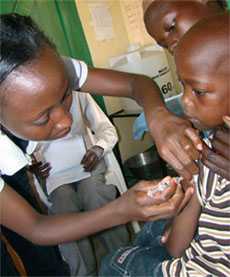Conducting Research and Monitoring & Evaluation
Since 1979, CDC has worked with the Government of Kenya, other U.S. government agencies, and international donors to implement research in Kenya that has provided an evidence base for life-saving public health interventions, like insecticide treated bed nets, that are used around the world.
Research
Over the past 35 years, CDC has partnered with the Kenya Medical Research Institute (KEMRI) to build a comprehensive research platform, which includes research on HIV, tuberculosis (TB), malaria, emerging infections, neglected tropical diseases, and other public health issues. The platform is well equipped to test new diagnostics, vaccine candidates, and new treatment regimens.
One priority area is HIV research, which focuses on evaluating methods to prevent the spread of HIV and improve the health of persons living with HIV. CDC and KEMRI, leading the only research site in East Africa, participating in a multi-country study of discordant couples (a stable relationship in which one person is HIV-positive and the other is HIV-negative), contributed to the ground-breaking research that showed a 96 percent reduction in transmission of HIV to HIV-negative partners when the infected partner was on antiretroviral therapy. These results have influenced health policy and clinical practice in Kenya and around the world.
Each year, 1.5 to 2 million people worldwide die from TB disease. CDC and KEMRI are researching innovative ways of preventing, detecting, and treating TB among adults and children, including among people living with HIV for whom TB is one of the leading causes of death. One research project recently launched by CDC, KEMRI, the MOH, and the U.S. Agency for International Development will pilot three approaches to improving TB case detection, each of which is feasible in Kenya. Each approach will be piloted in separate areas and the change in case detection using each approach will be compared to the change in TB case detection in areas where no intervention was implemented. This will aid the Kenya MOH in identifying which strategy has the greatest population-level impact on TB case detection.
CDC and KEMRI’s long standing research collaborations and well established platforms are able to support complex vaccine research. In collaboration with key partners like Aeras and the Program for Appropriate Technologies for Health (PATH) Malaria Vaccine Initiative, research to test an improved TB vaccine and malaria vaccine candidate is in the advanced stages. Following a safety and efficacy study, the research will determine the most effective dose for infants for the improved and modern vaccine. This gold standard clinical trial is the first of its kind in over 80 years.
CDC and KEMRI, in partnership with the Ministry of Health and PATH, are also conducting a trial for a malaria vaccine candidate. The study is being carried out in three sites in Kenya and six other countries in sub-Saharan Africa. Thus far, this malaria vaccine is 55.8 percent effective in reducing the frequency of clinical and severe malaria in children 5-17 months.
Additionally, CDC and KEMRI’s research focuses on neglected tropical diseases (NTDs) to better understand the immunology, prevalence, and geographic distribution as well as to study the impact of NTDs in persons co-infected with HIV, TB, or other diseases. As a result, CDC Kenya and partners are able to develop more effective prevention and control strategies.

Child receiving vaccine in a clinic
Program Evaluation
Through the U.S. President’s Emergency Plan for AIDS Relief (PEPFAR), CDC Kenya reduces the impact of the HIV epidemic by supporting HIV prevention services - such as HIV testing and counseling, youth risk reduction, and prevention of mother-to-child transmission - as well as care and treatment services for people living with HIV. CDC Kenya studies how these HIV services are implemented and their impact; evaluates best practices to determine what needs to be improved; and determines when effective activities should be scaled-up. Program evaluation activities include analyses of program impact, efficiency, and cost effectiveness to guide future program planning and decision-making.
- Page last reviewed: March 30, 2015
- Page last updated: March 30, 2015
- Content source:
Global Health
Notice: Linking to a non-federal site does not constitute an endorsement by HHS, CDC or any of its employees of the sponsors or the information and products presented on the site.


 ShareCompartir
ShareCompartir